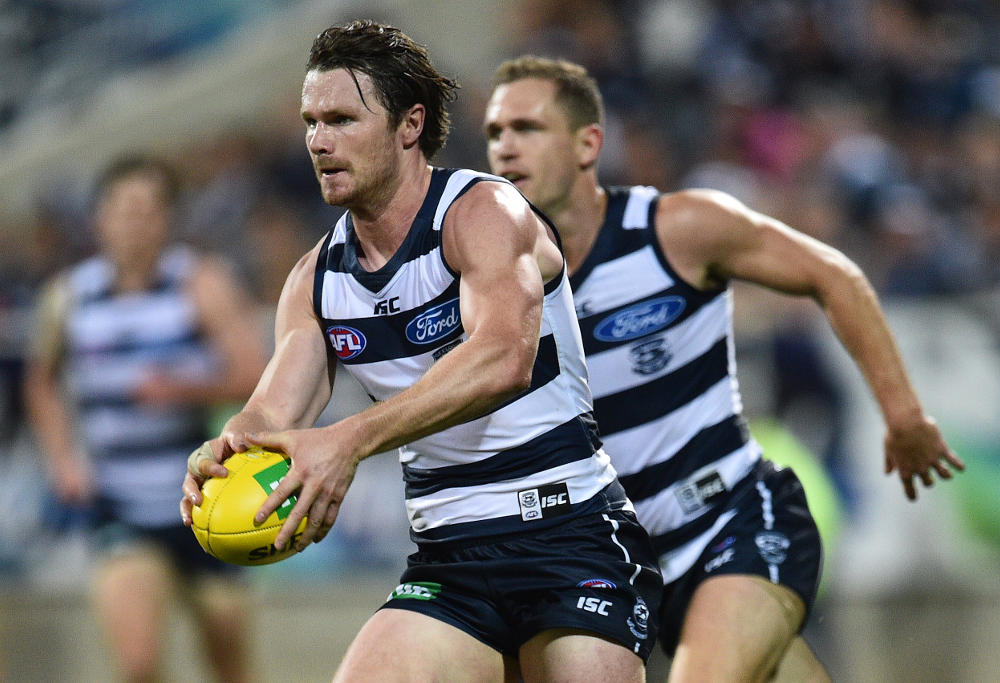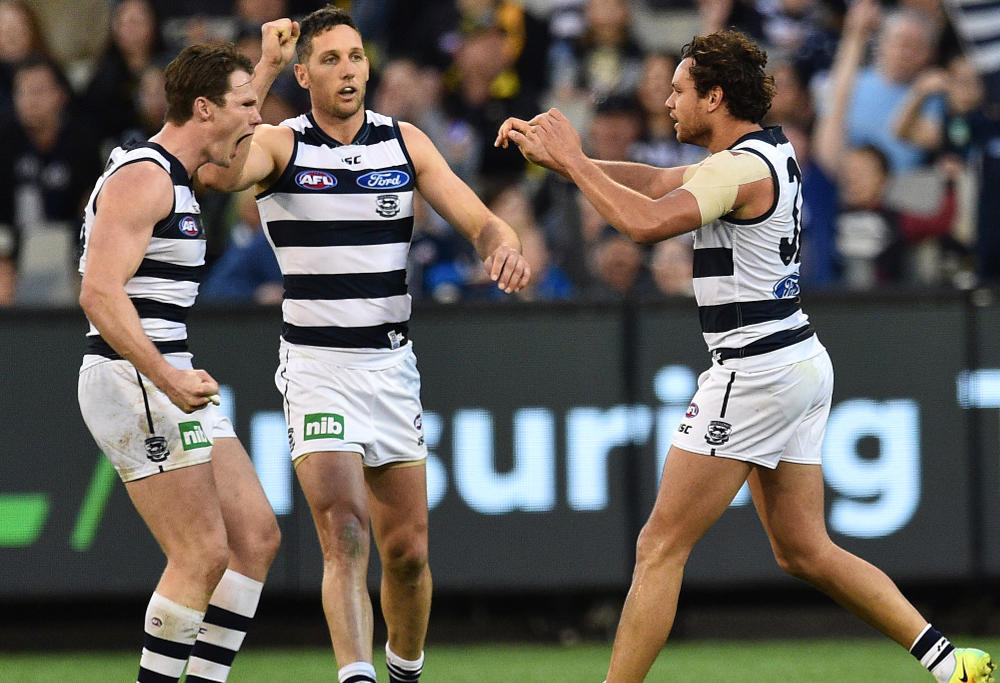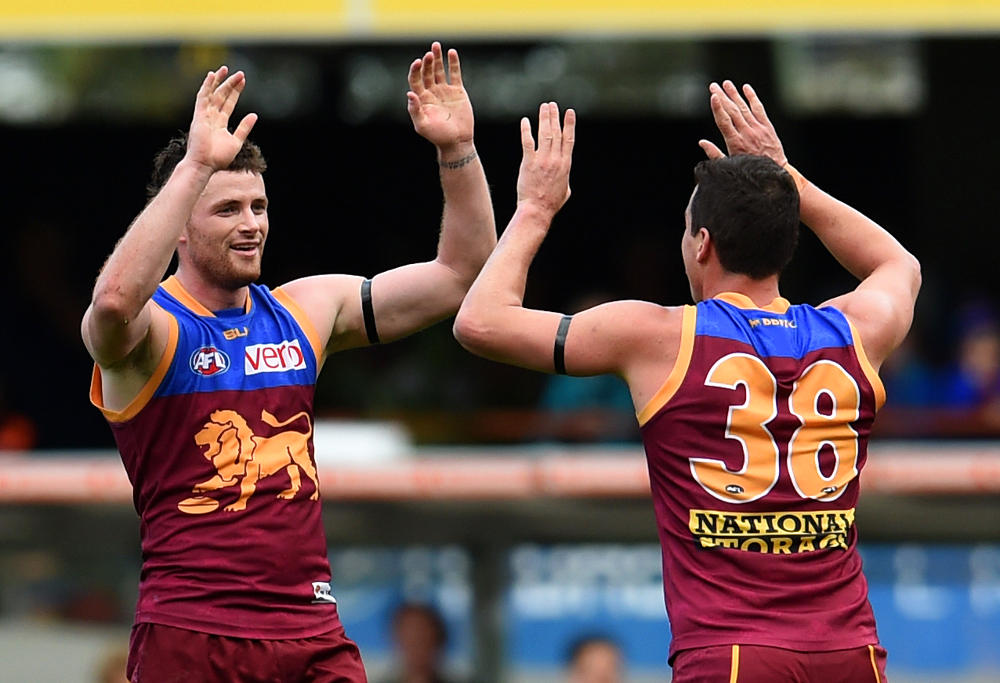Geelong have the services of Patrick Dangerfield for at least four more years, which is important because the Cats have a few holes in their list to fill in October.
Dangerfield just completed one of the most amazing single seasons in AFL history. It was capped off by a record-breaking 35-vote performance in the Brownlow medal, to go with his sweeping of practically every individual award in 2016. There is little doubt as to his power to create scores on his own, and his ability to not just create space through run and carry, but to suck opposition players into the Upside Down by putting on his unique afterburners.
In the week before the finals commenced, I introduced the DangerZone. The DZ charted the top 30 players for metres gained per game and the top 30 players for clearances per game on both of those metrics.
There is a very clear trend in this: the best clearance players tend to have low metres gained, and vice versa – there’s almost a gravitational pull at either end of the chart. There are a group of half a dozen players that sit as above the average of the top 30 in both metrics – check out where Dangerfield sits.

He is in his own solar system.
Having a player of this ilk is a really good thing. 35 Brownlow medal votes hasn’t happened before – indeed, Dangerfield is the ninth player in modern times to have earned 30 votes in a single year. Having he and inside warrior Joel Selwood running the point is a shortcut to good football.
But as for the rest of the Geelong side? There are holes everywhere you look. Not major holes – the Cats won 17 games with a percentage of 143 this season, despite losses to Collingwood, Carlton and St Kilda – but gaps in their playing stocks that can be exposed in individual games.
That is undoubtedly what happened to the Cats in their preliminary final. Sydney are as close to a complete football team as any team in the post-2000 era. The premiership Hawks, the pre-2010s Cats, the threepeat Lions and the current Giants teams have very few weaknesses in their playing stocks. Sydney are at that level, having unearthed a treasure trove of young and bargain-basement talent to complement their blue chip core.
Geelong? Well, there’s talent there, but not of the same quality as those sides who’ve gone on rampant runs at the top of the ladder.
It means the Cats enter this off season with similar stakes to the last one, albeit with one key difference: they have their superstar.
The guts
We’ve known all year that the Cats were thin through the middle of the ground. Geelong’s big midfield move of last off season was to add Dangerfield at the top of their depth chart and slide everyone else down a position – that’s a gross oversimplification, but personnel wise that was pretty much it.
But it was effective. The Cats had deteriorated from first to worst in clearance and contested possession differential between 2008 and 2015; they rectified that this season. Geelong surged from 13th to fourth in contested possession differential during the home-and-away season, and from last to third in clearance differential. The scale of the improvement is remarkable.

But, it has evidently been driven by two players: Dangerfield and Selwood. Geelong are second in the league in clearance executions by their top two players with 315. Sydney are first on 337, and the Eagles are third on 299 – Gold Coast down in 18th with just 163 between their top two (remarkably, Gary Ablett and Dion Prestia are one and two for clearances at the Suns this season despite each playing just 14 games).
That’s a great thing for Geelong. Adding Dangerfield has led to a marked improvement in Geelong’s ability to win the ball in the middle of the ground. The pre-season question, “how much can one player improve one of the worst midfields in the competition”, has been answered definitively: a lot.
But, the improvement has been far less pronounced among Geelong’s broader midfield group. The Cats rank second in clearances won by their top two clearance winners, and 13th among players third through to seventh on their clearance win tally board.

Geelong are one of four teams whose top two clearance winners won more than their next five highest clearance winners combined. The others are West Coast (more on them next week), Carlton and Fremantle. Every top eight side bar West Coast and Geelong ranked in the top seven for clearance wins by players ranked third through seventh – Melbourne, ranked fifth, stop this from being an exclusive finals side club.
That’s not to say this is inherently good or bad. The Cats won 17 games this season, where Carlton and Fremantle won just over half of that combined. The Eagles did okay this season, too. But it does illustrate Geelong’s challenge: they need more quality running through the middle of the ground.
Any sane, considered person would consider it unlikely Dangerfield will be able to back up next year. Joel Selwood is, somehow, still one of the most reliably uninjured players in the league despite the way he plays.
Should either or both of them regress a little next year, or be injured for any stretch of time, questions will be asked of the next tier of Geelong midfielders. On 2016 form, they would fail.

Two new forwards and one new back
It doesn’t end there. Despite their bevvy of tall players, the Cats are a couple of forwards short of a functioning attacking set – an issue which manifested itself frequently throughout the year.
Geelong’s home-and-away percentage of 143 is really good, but was driven by a miserly defence rather than a fully-functioning offence. The Cats scored 101 points per game by virtue of will and determination, otherwise called repeat inside 50 entries. Their issues with poor inside 50 entries are well known, as is their tendency to kick-and-hope or take shots from difficult locations.
The Cats’ forward line looks slapdash, particularly when compared to the more clearly-defined positions and roles Geelong exhibit across the rest of the ground. Tom Hawkins is the power forward, and Lincoln McCarthy the small forward, but otherwise it is a cavalcade of resting ruckmen and flakey midfielders. Daniel Menzel kicked 33 goals in 18 games this year, but I’m not sure what his defining AFL characteristic is.
Geelong’s midfield dominance and hardy press should translate into a high-scoring football machine. The real result is a notch above so-so. They’re heavily reliant upon their midfield remaining potent.
The issues are less pressing in defence, where the Cats are likely to retain their competitive advantage for some time. As we discussed a couple of weeks ago, Geelong are built to dominate in the air, particularly in defence. They recorded a season-long differential of +5.3 contested marks per game – the next best was Sydney on 2.6, and most teams fell in the 0 (+/-1) range.
In this regard, Geelong’s defence is built on depriving their opponents of territory and possession. The Cats allowed their opponents inside 50 a league-low of 44.5 times per game in the home and away season, almost 20 per cent below average, and were fourth in time in possession allowed at 39.4 per cent per game. Geelong conceded 100 points twice (the fewest in the league) and were never blown out.
There are few questions to be answered here – although the potential retirement of Corey Enright and (maybe) Tom Lonergan could force the Cats into some action. Even then, Chris Scott and company seem to hold some faith that Tom Ruggles can be a good mid-sized defender (just don’t give him the ball), while Jed Bews can play a bit in the same mould.
Geelong will also get Jackson Thurlow back next season, who will add attacking flare from half back that has been provided mostly by Enright this season. He’s as good as a new trade.
As for talls, Jake Kolodjashnij is developing nicely, and looms as a permanent replacement for Lonergan. Harry Taylor is evolving into a full back as his career progresses, and Lachie Henderson is much better player than the one who was put to the sword over the weekend.
This looms as an area of the ground that the Cats can afford to let be for now. Some extra depth would be nice, and they will need to see continued improvement from Ruggles, Bews and Kolodjashnij to remain at their peak. A free agent addition wouldn’t go astray – and there are going to be plenty of defenders on the market this season – but it’s unlikely to yield much.

Now comes the cream
The Cats are sorted for ruckmen. They’re reportedly set to lose Nathan Vardy after the 24-year-old fell well down the pecking order in 2016. Mitch Clarke’s future remains clouded, but even if they lose that pair the Cats have 2.5 ruckmen on their full list, and two more on their rookie list.
Instead, this coming player exchange period represents a chance for the Cats to fill their holes up forward and through the middle of the ground.
There has been talk in recent days that Geelong may look to build a “Big Three” – Dangerfield, Selwood, and Player X. Inappropriate NBA references aside, it does feel like a prudent course of action.
Daniel Wells seems to be the name linked most frequently from the credible sources. Wells would slot in perfectly alongside Dangerfield and Selwood, adding a touch of outside class and pace to the more heavy hitting pairing. He’s hardly a slouch at the contest, either. Adding Wells would be a risk given his injury history, and would likely slap a used by date sticker on the mascot’s forehead, but as the Cats showed in last year’s off season, being young is over-rated.
Brisbane’s Pearce Hanley’s name has also come up far too frequently for the smoke to be coming from a fire started by a journalist. Hanley’s best season was 2014, where he averaged 25 touches as a hybrid half back-inside midfielder, using a quick first step to create separation between he and his opponents. I would imagine he’ll stay at the Lions, but the Cats would do well to ask a question or two.
The vultures are circling Richmond, and Brett Deledio – slam dunk proposition wherever he would care to play – would suit Geelong just nicely. I trust I don’t have to explain why. Again, good luck prising him away, but it’s fun to think about these things.

Adding a player or two of this calibre would allow Josh Caddy to play as a permanent forward, a role he seemed to enjoy in the fits and starts he was afforded in the latter part of the season. Mitch Duncan can be freed to roam the half forward line as a Deledio-lite type, and Jimmy Bartel can help give more time to Lincoln McCarthy to develop.
There’s plenty of bargain options in the delisted free agent bin, too.
Melbourne de-listed veteran Jack Grimes yesterday – if healthy he’d give Scott Selwood a run for his money. Nick Dal Santo has another year or two left in him, and is precisely the kind of player the Cats are searching for. If they can get him right, Anthony Morabito is also a good fit.
They’re the potential game changers; there’s likely to be value lurking in the delisted pool in the months ahead. When you consider the Cats went into the preliminary final with Josh Cowan and Sam Menegola in their midfield, there’s potential upside. Menegola has been an excellent pick-up, but looms as a 22nd-man type of player for a premiership side.
Complicating matters is the fact the Cats are fresh out of picks, or more specifically, the ability to freely leverage their picks. Geelong traded out of the first round in both 2015 and 2016, meaning their ability to leverage their 2017 first rounder (currently 16th, but with academy selections that’ll drift closer to 20) is more limited. Trading it would mean they must then go to both the 2018 and 2019 drafts and use a first round pick, as it’s difficult to foresee a scenario where they’re able to both bring in a high-quality player and either retain their first round pick or move up in the order.
There are scant tradeable players on the list, too. Steven Motlop’s name has been floated, which is interested given an oft-cited criticism of the Cats is they lack outside pace – he is arguably the only non-Dangerfield with speed to burn. The aforementioned Vardy trade could yield a pick, but once again, it’s unlikely to move the needle for a club that is shopping a highly rated talent.
Shane Kersten ended the year in and out of the team, after a solid patch of football to start the season. His name had been firmly linked with Fremantle earlier in the year – the Dockers are hungry for forward line talent, but they aren’t quite ready to lick the moss off of rocks. There are plenty of youngsters that still need some incubation, but offloading them risks tipping an already precariously placed list over the edge in a year or two.
It means the Cats are in as delicate a position as they were a year ago, in their pursuit of Dangerfield, Smith, Henderson and Selwood. With nary a trade asset to spare, the Cats will most certainly be active in the free agent market, to the extent they can afford.
This year, Geelong proved Cats have more than nine lives. An 11th is almost assured, because of the singular talents of Patrick Dangerfield and Joel Selwood, and a finely crafted defence that has proven to be up to stopping the best.
But to take the next step with a sense of surety, the Cats must double down on their bold list management strategy in a fortnight’s time.



































































































